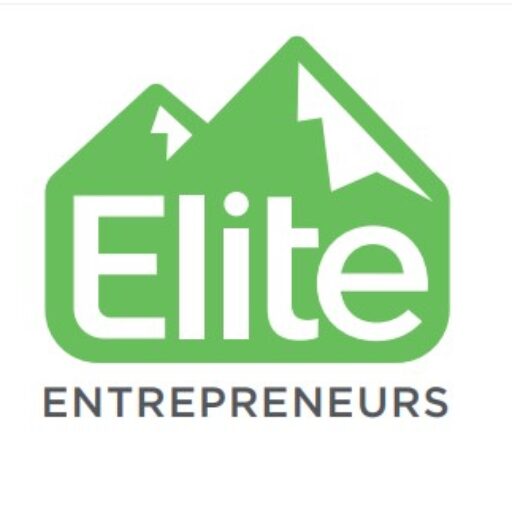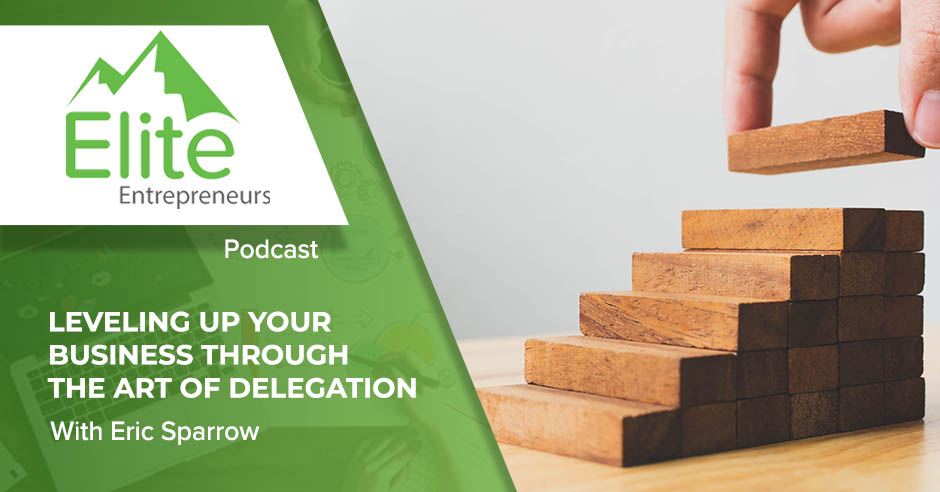Episode 138: Leveling Up Your Business Through The Art Of Delegation With Eric Sparrow
Watch the episode here
Listen to the podcast here
Every entrepreneur would want to see their businesses grow and expand. But alongside the exciting endeavor of scaling your business is your duty to master the art of delegation. Sitting down with Brett Gilliland is the Founder of Milkhouse Candles Company, Eric Sparrow. He shares how he realized the importance of work delegation as their business grows from a simple hobby to a full-fledged company with several employees. Eric explains how learning to let go of his responsibilities brought his business to the next level. He also talks about the importance of hiring efficient people and keeping them satisfied at all times, which ultimately leads to top-notch customer experience. Check out this podcast as well as learn more about delegation through our business coaching program!
—
As you know from reading previous episodes, I always get super excited about introducing my special guest. This episode is no exception. I have here somebody whom I have known for a number of years and whom I admire greatly. His name is Eric Sparrow. He is the Founder of Milkhouse Candle Company. As part of his little bio that he submitted in preparation for this interview, the little quote says, “I had no idea that the world was so hungry for a cleaner burning scented candle.” With that, I’m going to welcome you to the show, Eric. Thank you for being here.
Thanks, Brett. It is great to be here.
Your bio mentions that you started that candle company at your kitchen table with your wife, Janet, back in 2002. I love for you to tell a little bit of that story so we have some context about who you are and what your business is about.
My wife Janet and I, when we were dating, we made candles on a couple of our dates because it was fun. We had an outdoor wedding. We knew we needed a bunch of candles on the table for an outdoor wedding. Candles can be expensive. We should buy decent ones. We had it as a hobby for a little bit so we decided to make our candles for our wedding.
It became a little bit of a passion because here we are in Iowa and most candles at that time were made of paraffin wax. We are surrounded by soybeans. There was this new thing at the time called soy wax that could make candle wax out of soybeans. We loved the challenge of trying to make a great candle out of soybean wax, which is more challenging to use or make a great candle out, especially at that time. When it was new, it was difficult to make a great candle out of it.
For our wedding, we made these candles. The challenge of making a better candle became apparent to us. We are both competitive people. I was a third-grade teacher at the time and my wife was an occupational therapist who worked in several nursing homes. As we experimented with our candle formulations, we took them to the workplace and sold them for what we had in them. One thing led to another. Every time we leave with a trunk full of candles, one day, we come back with a pocket full of cash. We reinvested that cash into making another batch of candles that was better than the last one until we realized, “We are awful busy doing this.”
We started getting some calls to sell wholesale because somebody got a candle as a gift from a fellow employee of Janet’s or a fellow teacher of mine, gifted one. It became an accidental business for us but driven by a passion for creating something better. I have always been entrepreneurial. I have always dreamed of owning my thing. It got to the point where we were working until midnight, making candles, getting up in the morning and gluing labels on jars. It is old school, gluing them on with glue, printing our labels in the printer and cutting them out by hand. It is a simple way to find our way into this business that eventually had me quitting my teaching job and taking a chance to start something of our own.
For a while, you did this out of your home.
We did it out of our kitchen. There is a room off the kitchen. We called it the elbow room because that is about how much room there was in. We ended up building a little table in that and setting up some jars. On a good day, I could probably make 20 or 30 candles and that expanded. We were hauling our candles to craft shows to get them out there and preaching to the soy message, which is, “It is a cleaner burning candle. It is a new wax.” It was unique at the time.
We are able to educate our audience on it, build a brand and find more wholesale accounts. We realized that we had a need for more products. We ended up signing a lease on a local bakery that had been sitting vacant for a while but it had a decent kitchen and some good utensils in there that we could use for mixing things and a good stovetop. We moved into this bakery, which was over 1,000 square feet. We were in heaven. We are like, “We will never use all of these square feet. This place is huge.” Within six months, we were bursting as it seems.
Not to ruin the punchline yet but how many square feet are you in now to make your candles?
We can probably get there pretty quickly, as far as punchline’s concerned. We moved from this 1,000 square feet. We have found another building within a year and a half. It was 3,000 square feet. It’s the same deal, Brett. We were like, “We will never use all this space.” Within a couple of years, that was way too small. We found 10,000 square feet.
As of this episode, we have been doing this for about twenty years in 2023. We are in about 250,000 square feet over 3 facilities. The situation has never changed. You are getting into more square feet. I can’t believe how big this is. A few years ago, we built a new facility that was 20,000 square feet. While we were in the process of building it, we realized, “This place is way too small.” We were able to pick up the building next door, which was an additional 10,000 square feet. Now that is way too small.
Our newest acquisition is 136,000 square feet. It is not even in the same town but it was the quickest thing we could do, considering it is expensive and it takes some time to get a building built. We realized that there are many opportunities to wait. We took on a good lease on this facility which is 136,000 square feet. It will give us some nice opportunities to grow.
The upgrade from the kitchen to your first 1,000 square feet to 250,000 square feet. You will need more at some point. That is a lot for a several-year journey. Rewind to when you and I met. I will get the year wrong but let’s pretend it was 2014-ish. You were out of teaching at that point. Janet was still working, if I recall, as an occupational therapist. She hadn’t quite made the decision to join the business full-time. You guys were about $1 million or approaching $1 million in revenue at that point.
Tell all of us what some of the growing pains were like or things you were trying to problem solve as a business owner outside of space. With manufacturing things, there is a better manufacturing process for their space. I want to focus on some of the leadership journey or the organization development stuff you were working on.
It is fun to dream about that. Prior to meeting you, we were at about $1 million. We were used to growing about doubling every year up to that $ 1 million point. For some reason, we are stymied out. We never shrunk. It seemed like growth was slower and took more effort than we were used to. Moving up to that, in 2014 when we met, we were trying to figure it out.
As an entrepreneur, I love building stuff. I love getting my hands dirty. I love being and leading from the trenches. The problem was that that was not what the business needed anymore. The business needs to do something different from its leader. While we were trying to figure it out and we weren’t spinning our wheels, we were growing but it felt like we were spinning our wheels because we had grown so much quicker to get to that point.
The reality is we didn’t know what we didn’t know. That is when we met you. We met you through Elite Forum back at that time. Janet worked as an occupational therapist. It is important to mention that when I decided to quit my teaching job and do this, we didn’t have kids at the time. We had a very intentional plan. It is important. An entrepreneur needs a little bit of a plan because I’m scatterbrained. I’m quick to say yes and figure out the details later. I’m lucky that Janet is detail-oriented. We are a good match for each other.

Art of Delegation: Entrepreneurs need a little bit of a plan, especially those who have a pretty scattered brain who quickly agree to anything.
We were able to sit down collectively. Our math was simple. I needed to make the house payment and pay the heating bill with whatever revenue I took in. We budgeted that Janet’s revenue would take the rest. As a teacher, I could always substitute teach. I could always call the school and say, “Do you need subs now?” Every day of the school needs subs.
My goal was $1,000 a month. I had to bring home $1,000 a month. Everything outside of that, we got to reinvest in the business. We grew it and Janet kept her job. Fast forward to 2002, when this business started, the same year that we got married, along comes Brett. We had to go to Arizona and get a little consulting. I’m like, “Are your business stuck at $1 million? Yes, it is.”
You saw good growth for most of that time. That started to flatten out a little bit. You weren’t quite sure why. I hate to drag you through a painful memory but do you remember anything difficult or frustrating? There doesn’t have to be anything but sometimes I talk to business owners and they were like, “I was pushing myself. I was near the point of burnout. I felt like all my team wouldn’t own things. They weren’t accountable.” There are different ways that some of this manifests itself and I wonder if you remember anything being frustrating and trying to make this thing go.
It was the need to control everything. Leading from more than the trenches, for me meant that I’m on the candle-filling line. I have got people answering the phones. I got some sales being made but for the most part, people were leaning into me for those answers because I hadn’t done a great job of delegating. We hired a great guy. It is someone that was a retired teacher at the school where I worked in. One day, he said, “Sparrow, get out of here. Get off the filling line. We got this. We love that you are here but give us a chance to show that we can do it.” That was my wake-up moment.
You got to delegate. This only works if you can trust that others will get it done. Since then, it has gotten a lot easier. Delegation is very hard, especially for an entrepreneur who wants to look at everything and make everything better. The reality is even if they only do 80% as well as I do, the fact is, I don’t need to worry about it and I can pour 100% of my effort into something else. That is big.
Delegation only works if you trust others that they will get the work done. Share on XThat is a big moment when you realize, “The business can only grow as far as I can hold it if I’m involved in everything. If I start to let go, let other people do the thing, even if it’s at 80%, that still allows me to do something else and that thing still happens.” You and Janet come out. We get to know each other and be part of an experience you have already referenced as Elite Forum. During that time, we taught you some principles about what it takes to grow from $1 million further to grow past that $1 million mark, get out of the way and stop porting all the control things. You went and did it. How much longer after that did Janet work as an occupational therapist?
A couple of months. We went through that process in June and she was working with us full-time by August, perhaps.
If my memory serves well, that is always a dangerous proposition but it seemed like it was within the year or a few months. We did have some breakthroughs and we won’t get into that here but you guys did some foundational work as part of that experience that gave her the confidence to say, “We are going to do this. I’m in.” You guys started your steady ascent again after that. Fast forward, you mentioned 250,000 square feet. What sense can you give our audience around the number of employees, revenue or anything else that would help them understand how far you have come in the last several years since we met?
When Janet quit her occupational therapist job, we were at about $1.5 million. We were at twelve employees. Janet came on board. We set the vision, put core values in place and had discussions with every member of the group to say, “This is what it looks like moving forward.” We lost one member through that, which was perfect. She wouldn’t have fit into the values and was having a negative impact on the culture.
When Janet came on board, we instantly doubled. Janet, as an occupational therapist, said she wants to help find tools to make sure that people aren’t getting injured. There is not too much repetitive motion. We are trying to grow this thing. We need to take better care of our people. She enters as our HR gal and realizes the tool we need is more people. She goes on a hiring frenzy.
That was a huge year for us because it was able to take us from this stymied $1 million to $1.5 million point where we instantly boom. We went straight to $3 million like that. We know the $3 million is also another plateau but we knew how to deal with it this time. It was between 2014 and year-end 2013 when we learned all of this but hadn’t fully implemented everything, at least not for a full year where we did a $1.5 million. In 2022, we did over $30 million. It took us a long time to get to $1.5 million but to come from $1.5 million to $30 million was not 8 years.
The foundation of what we learned through that, practicing that and even practicing the ideas that have come from the time spent with you, Brett, always be learning and talking with others who have that experience or coaching others who aren’t there yet or learning from those who are willing to share that have been where you are, that is massive. It is such a big deal because, in general, entrepreneurs love entrepreneurs. They are so delighted. They were like, “You know the secret entrepreneurial handshake.”
Entrepreneurs generally love entrepreneurs. They want to learn and coach each other. Share on XI finally don’t feel alone. You get me. There is a connection. You had a ton of growth and success. Let’s try to pull out the nuggets. We can’t get to all of them but maybe the top 2 or 3 things that were game-changing for you in your growth journey to be able to go from $1.5 million to $30 million. There are tons of lessons that you have learned but some core things that helped you in your journey and/or some of the things you had to figure out as a team or as an organization would allow you to go past some of those earlier stopping points.
From a business growth perspective, customer experience is everything. It doesn’t matter what business you are in. We are all in the same business and that is serving your customers. If you are not giving your customers what they want and what they are willing to pay for, you need to look at yourself and your business. That is key. Realizing, “My customer needs this. How do we get it for them?”
We are in the candle business. Nobody ships candles for free. They are heavy and fragile. We are going to do this because their customers need this. They need to understand. I’m willing to give up some margin to give my customers what they want. That is one of those things. As an entrepreneur, people will think you are crazy a lot. You will make a lot of mistakes along the way. When you firmly believe in a thing, don’t ever hold back because someone said that they don’t believe that is the right thing to do.
If you firmly believe it, we will prove it. We did it with free shipping. That is a big thing for us in the candle world. By doing that, orders came in like crazy. We need to support that with more people. Between serving your customers, delegating well, being willing to get out of the way and finding a system for delegation and hiring people who are more experienced than you are in the business, think of our businesses on this path upward. If I hire people up above that, they are going to help pull that up.
If they are not learning, bringing themselves up, educating themselves and making themselves better through that process so they can continue to pull up, there are times when at some point, people are beyond their comfort zone for what they are willing to learn. They are potentially pulling you down if your growth line is above them.
It is okay that they understand that there is a time for everybody. Maybe this isn’t right for you anymore. Maybe you like working for a $2 million business and we are doing $10 million. That is okay. There is no harm, no foul and nothing against you personally. It is what we are all comfortable doing. Recognizing what people’s strengths are, serving your customers well and delegating well have been my big three things.
It seems that, for most people, at least in the smaller business that is growing, they find a sweet spot that they are like, “I am comfortable in businesses that are in this little leg of the journey.” $3 million to $10 million, let’s use it as an example. If you have somebody who comes in and helps implement processes and systems to grow a business from $3 million to 10 million and they start to be a little less comfortable from $10 million to $30 million, they might find their next job. It might be back in $3 million to $10 million where they feel comfortable. I have seen that quite a bit. For you to unsolicited mention, “I want to find somebody that is ahead of me that might help me pull forward into that space.” To say that some are not readily moving forward. They feel comfortable in a spot. That resonates with things I have seen.
It is important as an employer to make sure people understand that because I have had conversations with good employees who suddenly weren’t good employees anymore. You have to maintain that good relationship. You hear things and I have heard this several times like, “It is not the same as when I started. It is different here.” It was like, “Yes because we are bigger. We have different needs. If you haven’t grown with that, it is okay. Let’s help you find that business out there that maybe is where we were.” It is planned when nobody wants to keep a business exact. No one says, “I want to plateau a business.” They want to grow and build one. It is important to communicate that with your employees.
I want to rewind to something you said about the revenue growth you experienced from your kitchen to 2014 or 2013 when you are coming up on that $1 million mark. You said, “When Janet quit her job and joined in late 2014, she made this about people.” She was like, “Let’s figure out how to help people be well in this environment for the long-term.” You said a hiring frenzy.
Something that I have started to clue in on over the last couple of years and I want to test it against you as a working hypothesis that I have is that the first 0 to $1 million or so roughly is all about growing the business one customer at a time. One more sale, get that product sold and out the door. At some point, when that thing gets off the ground and that business hits that $1 million mark or somewhere north of there, it doesn’t take away the importance of sales. At some point, the business grows one person or employee at a time.
I believe there is this shift where the capacity to keep going relies on bringing in that next person or maybe there is a systems investment you can make. If your business requires people to grow, you are going to grow one person at a time after that. That is not one of those infallible laws of the universe yet. I’m still working on it. I’m curious because you said you guys doubled. You went from $1.5 million to $3 million pretty quickly. It seems to have corresponded with Janet coming in and start hiring people that could help you get there. Plant that one in your leadership toolkit. You grow by getting the right people.
It is common as we talk to other manufacturing facilities. Every business is different. As a manufacturer, we were finding that you could expect to baseline make $100,000 top-line per employee. That is where we were, a little over $1 million with a little over 10 people. When we got ourselves to 25-plus employees, we were closer to $3 million. It is a great baseline for those out there who are in a similar space to where we are.
We have gotten to work on, “How do we get more top-line revenue per employee?” It has become important because, hopefully, top-line revenue equals bottom-line revenue if you do things well but especially in this world where we do need to pay people more to keep them happy. Inflation has taken a toll on a lot of people and we want to make sure we are taking care of our customers.
As a leader, it is important that you focus on the efficiency of your operation and make sure that when you hire a person, you have an expected result of what it is going to do for your revenue and always working to improve that. It is not to put money in your pockets. It is to make sure you are taking care of the people who are taking care of you.
The benchmark may be a little different for other industries. I like that revenue-per-employee approach. There are two sides to that. One is, “When can I afford to hire my next person?” If the revenue is not there, we got to make sure the revenue is there for us to hire but it is going to be hard to push past the revenue mark without more help. Both sides of that revenue per employee number are important to look at.

Art of Delegation: Always check if you have enough revenue to hire the next person. Nevertheless, you need additional people if you want to push past your current revenue mark.
You talked about customer experience and taking care of your people a few times. Why don’t we end this and see how this goes? Unplanned here, unscripted as always. What is the relationship in your mind between creating and maintaining an outstanding customer experience? How do you take care of your people? Who do you bring in to be part of that?
Customer experience is everybody that you are associated with. When I say customer experience, I say to my entire crew, “I’m not talking about the end user of a Milkhouse Candle. That is a customer.” There is also partner experience. What is a store owner that is selling that product? What is their experience? It is why free shipping is a big deal. It is why they called me and said, “Half of my order was broken.” “No questions. I’m not going to make you prove it. I’m going to send it to you.”
Employees are some of your best customers. It’s the people that spend their valuable time away from their families to come and spend making a great product. They got to be happy so that they are excited to come to work every day. Sometimes you have the right people in the wrong seats. You need to evaluate that and say, “I got this great person but she doesn’t seem to be happy in the role that she is in.” What are her superpowers? Maybe she would be better over here.
We don’t ever give up on anybody when we find good people that seem to not be in the right place. There are many places as we grow this business. Maybe they are better on a manufacturing line or talking to customers on the phone. Everyone got their superpowers. It is what I like to call them. What cape are they wearing?
It is important to recognize that everybody you associate with in your business is a customer. I always make the statement, “I want everybody to be wearing a Milkhouse Candle shirt.” On the front of it, if you are an employee, it says, “Why would you work anywhere else?” On the back, it says, “You wouldn’t. Why would you do that? This is the place to work.”
For a store owner to say, “Why would you carry any other brand? You wouldn’t.” For a consumer to say, “Why would you burn on any other candle? You wouldn’t.” My goal is for everyone that we are associated with to willingly wear that shirt and know we’ve done our job. Until then, there is a lot of work to do.
Sometimes I ask leading questions and I’m going to say them in a way that you would agree with. You said everything but this statement. The way you treat your team and the people you bring on board to be part of the Milkhouse Candle Company, you make sure that they are well-treated and happy so that the customer experience is as high and great as it can be.
In other words, you can’t maintain a great customer experience without great people. You went far as to compare your employees to customers because you want to treat them well. You live that philosophy but I want everybody to connect those dots. You cannot maintain an amazing customer experience if you treat your people poorly and have assembled a bad team. You got to have an amazing team of people and treat them like gold. They will treat your partners, your customers and everybody else like gold. You are a great example of that. I wanted to call that out specifically.
Eric, I could talk to you forever. We can’t do that in this format here. I appreciate you taking the time to talk about some of the keys to your tremendous growth. I know that goes beyond talking about revenue in a business. It goes to who you are as a person and what you have learned and become as a leader. It is fun to watch. Thank you for being a guest on our show.
Thanks, Brett. I appreciate being here. It is always fun chatting with you.
If people want to find out more about Milkhouse Candle Company or you, where would you send them? How would they connect? How would they learn more?
I love working with entrepreneurs. It is MilkhouseCandles.com. @EWSparrow is my Twitter handle. I’m new to Twitter. I feel like this is something I need to be a little better at but reach out to me via Twitter or even my email address, Eric@MilkhouseCandles.com.
Thank you, Eric. For everybody reading, please share this episode. Share our show with other seven-figure business owners or everybody who deals with these same issues. We are going to keep bringing great business owners with great insights and experience like Eric. We want to help as many of those seven-figure business owners as possible. Keep reading and we will see you next time.
Important Links
About Eric Sparrow
 Holy Cow! exclaims Milkhouse Candle Companys Founder Eric Sparrow when asked if he expected Milkhouse to be America’s fastest-growing soy candle company. I had no idea that the world was so hungry for a cleaner-burning scented candle!
Holy Cow! exclaims Milkhouse Candle Companys Founder Eric Sparrow when asked if he expected Milkhouse to be America’s fastest-growing soy candle company. I had no idea that the world was so hungry for a cleaner-burning scented candle!
Eric and his wife, Janet, started the company from their kitchen table back in 2002 with a desire to use Iowa-grown soybeans to create a healthier alternative to the paraffin-based products commonly seen in the candle market. Originally packaged in old canning jars found on their family farm, today’s Milkhouse products focus on packaging and fragrance design driven by customer feedback.
You can learn a lot by listening to your customers, says Sparrow. Keeping a laser-focused approach on serving our customers first and foremost has been the secret to our success!
Want to listen to more? View all episodes here >



